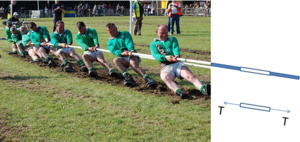
Back شد Arabic तान (भओतिकी) Bihari Εφελκυσμός Greek Tensión (mecánica) Spanish کشش (فیزیک) Persian Tension mécanique French מתיחות HE तनाव (भौतिकी) Hindi Tansyon HT Tarikan (fisika) ID

One segment is duplicated in a free body diagram showing a pair of action-reaction forces of magnitude T pulling the segment in opposite directions, where T is transmitted axially and is called the tension force. This end of the rope is pulling the tug of war team to the right.
Each segment of the rope is pulled by the two neighboring segments, stressing the segment in what is also called tension.
Tension is the pulling or stretching force transmitted axially along an object such as a string, rope, chain, rod, truss member, or other object, so as to stretch or pull apart the object. In terms of force, it is the opposite of compression. Tension might also be described as the action-reaction pair of forces acting at each end of an object.
At the atomic level, when atoms or molecules are pulled apart from each other and gain potential energy with a restoring force still existing, the restoring force might create what is also called tension. Each end of a string or rod under such tension could pull on the object it is attached to, in order to restore the string/rod to its relaxed length.
Tension (as a transmitted force, as an action-reaction pair of forces, or as a restoring force) is measured in newtons in the International System of Units (or pounds-force in Imperial units). The ends of a string or other object transmitting tension will exert forces on the objects to which the string or rod is connected, in the direction of the string at the point of attachment. These forces due to tension are also called "passive forces". There are two basic possibilities for systems of objects held by strings:[1] either acceleration is zero and the system is therefore in equilibrium, or there is acceleration, and therefore a net force is present in the system.
- ^ Physics for Scientists and Engineers with Modern Physics, Section 5.7. Seventh Edition, Brooks/Cole Cengage Learning, 2008.